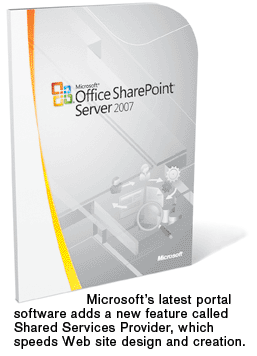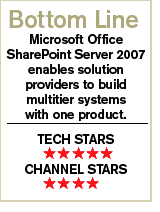Review: Redmond Outgrows Portal

In addition to its template applications, MOSS developers can purchase SharePoint Designer separately to quickly build new applications without having to rely on plain vanilla Microsoft design tools. SharePoint Designer eliminates most, if not all, of the coding when developing SharePoint workflows. Designers and business users can develop complex business rules to generate actions based on conditions that occur in the workflows. From SharePoint Designer, users can tap CSS to design a single site and propagate the changes to multiple sites.
Configuring MOSS to function on a global scale is only a matter of selecting a different set of installation options and database servers. Creating services for a Web farm requires just a few more steps than setting up services on a Web server. Administrators do not need to know what files are being generated during an installation. The only critical configuration file to maintain is the one with the name of all the databases.

MOSS 2007 has also simplified application management. After a developer creates a simple Web site in IIS with extensions for SharePoint, it is automatically treated as a Web application in SharePoint. The next step for a developer is to create site collections for that Web application.
By starting from a root site collection, a developer can create many other sites. First, a developer has to decide on the type of application that's being created and generate a site structure accordingly, or allow users to create their own. In a collaboration site, for instance, users create sites on an ad hoc basis.
Different databases can also be assigned to the different site collections. The combination of multiple databases to multiple site collections allows developers to scale out an application in a matter of minutes.
A site collection can exist from a single URL and can also expand infinitely. Through a setup wizard, developers can generate multiple roots within a site collection, each having a collection of their own. Using the same technique, site collections as well as other roots can span infinitely from each root.
The MOSS site hierarchy solves the problem of scalability by taking advantage of spanning site collections. CRN Test Center engineers found it to be the simplest and best way to expand an enterprise application.
Next: The Bottom Line With MOSS, applications with thousands of connections can quickly scale out by using many database instances on multiple Microsoft SQL Servers. Similarly, a multitier enterprise application running thousands of processes can benefit greatly because it can run many databases and funnel its data through a single master site collection.
Site collections are also convenient when integrating workflows from multiple Web applications. Each Web application can point to the same server or multiple servers and databases. Essentially, site collections are systemwide groups of applications. Therefore, MOSS can be used as a platform for building entire systems.
It's also possible to have two site collections point to the same database, so different Web sites can point to the same data. One common use for sharing a database is when a secured intranet site needs to pass information to an Internet site. Instead of passing data between two databases, developers can simply update separate tables from a single database.

To speed up Web site design and creation, Microsoft Office SharePoint Server 2007 arrives with a feature called Shared Services Provider, which can replicate common features from site collections every time they are generated. For instance, personalization features that use Microsoft Active Directory properties, search services and even Web Parts can be defined as shared services within SharePoint. Developers can use the shared services provider mechanism to reuse features across multiple applications.
One of SharePoint's best shared services is the Business Data Catalog (BDC), which simplifies the way data is passed between different resources and applications. The BDC provides access to structured data through an XML application definition file, which describes the structure of a data source and displays it in rows and columns.
Essentially, developers can connect the BDC to any data source that uses ADO.Net source or call a Web service. SharePoint arrives with Web Parts that will display BDC data, allowing Web sites and applications to share any data securely and quickly. However, not all relationships between data sources are mapped automatically by Web Parts.
BDC data is rendered through Web Parts and lists. A list column can also be created to collect data from a BDC. The automation allows end users to use this feature. Developers can open up data collections to end users that need to work with long lists. This is an easy way for developers to set up a work site without delving into Web site formatting.
Microsoft has one of the best IT training and certification programs on the market. The company's Web-based training is free for all partner levels and advanced classroom training typically costs $500 to $700 per week.
Microsoft states that partners can earn about seven times more than the cost of the licensing. Certified partners can also receive Visual Studio 2005 Professional, early betas, demo toolkits and other professional packages. In addition, qualifying partners receive business toolkits, presales, technical and critical phone support.
All in all, with its simplified deployment and development processes, SharePoint 2007 offers channel partners a quick way to build complex applications while leaving plenty of room for services opportunities.